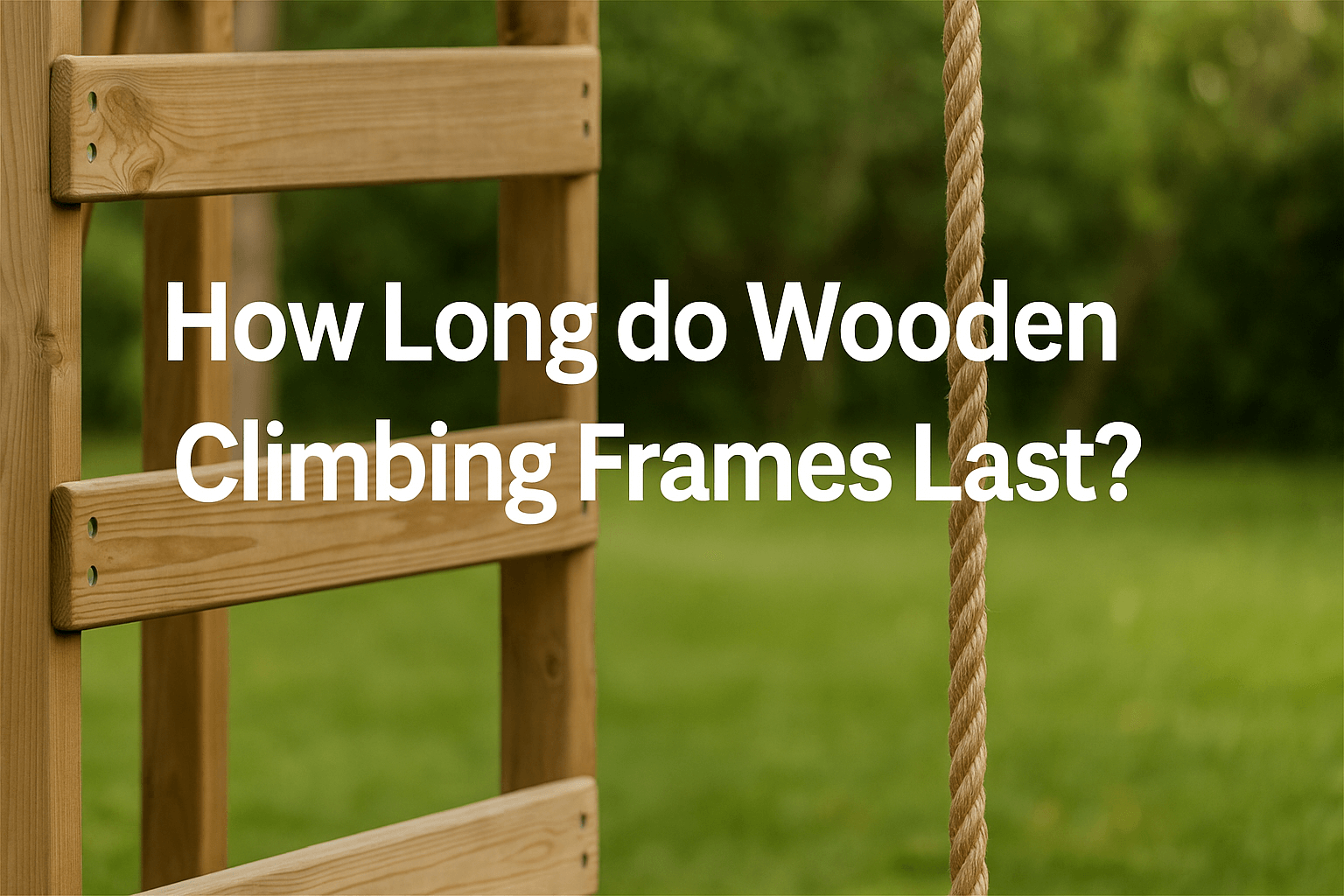
How Long Do Wooden Climbing Frames Last?
Bought a wooden play frame thinking it’d outlast your kids’ obsession with dinosaurs? You might be onto something! Most last 10–15 years — but only if you treat them better than your garden shed.
British weather, muddy boots, and wild weekday adventures can take their toll. So if you want your climbing frame to survive it all, keep reading — the tips below could make all the difference.
Understanding the Lifespan of Wooden Climbing Frames
Average Expected Lifespan
If you're investing in a wooden climbing frame, you’ll want to know it’s not going to fall apart by next summer.
On average, they last 10 to 15 years — sometimes longer if you’re lucky and careful. Frames made from premium wood and treated properly can push that up to 20 years. But the real difference lies in how you care for it. Neglect it, and you might be replacing parts far sooner than you’d planned.
What Influences the Longevity of Wooden Climbing Frames?
How long your play frame lasts isn’t just luck. It depends on what it’s made from, how it’s used, and what kind of weather it faces in your back garden.
Some parents find their frames still going strong when their kids hit secondary school. Others end up dealing with rotting posts after just a few wet winters.
Let’s break down what really matters.

Key Factors Affecting Durability
Wood Type and Quality (e.g., pressure-treated, cedar, spruce)
Not all wood is created equal.
Frames made from hardwoods like oak or beech are tough and naturally resistant to decay. Cedar is another winner — it’s soft but surprisingly durable outdoors. Pressure-treated softwood like pine can also work well, but only if it’s been properly treated to handle rain and rot.
Cheaper untreated wood? It may save you money up front, but it’s unlikely to go the distance.
Environmental Conditions (weather, sun exposure, moisture, rot, insect infestation)
The great British weather isn’t kind to timber.
Too much sun can dry it out and cause cracking. Constant damp? That’s a fast track to mould and rot. Add in frost, snow, or bugs, and you’ve got a full-on durability challenge.
If your climbing frame lives in a shaded, soggy corner of the garden, it’ll need more TLC. Good drainage and some sunshine are your best friends here.
Usage and Wear and Tear (children's play, stresses on the structure)
Let’s face it — kids don’t exactly play gently.
Whether it’s clambering up ladders three at a time or turning the monkey bars into an Olympic event, frames take a battering. And the more kids use it (especially older ones), the more stress that frame is under.
Heavy, frequent use doesn’t mean it’ll break — but it does mean you’ll need to keep a closer eye on wear and tear.

Maximising the Life of Your Wooden Climbing Frame
Essential Maintenance Practices
Regular Cleaning and Inspection (dirt, grime, moss, cracks, splinters)
Don’t let moss, mould, or grime build up — a quick scrub every few months does wonders.
Give the whole structure a proper once-over at least once a season. Look out for splinters, cracks, wobbly joints, or soft spots in the wood. If something looks off, deal with it early before it gets worse.
Your future self will thank you.
Staining, Sealing, and Protective Treatments (UV rays, weather damage, wood treatment for climbing frames)
Wood needs protection — just like your fence or decking.
Apply a good-quality wood treatment every couple of years. It helps block moisture, keeps UV damage at bay, and gives the timber a longer life. Look for a product made for outdoor play equipment, and always follow the instructions.
Avoid treating the wood in damp weather — pick a dry spell if you can!
Checking Fixings and Accessories (loose bolts, screws, swing hooks)
Swings, ropes, ladders — they all rely on bolts and fixings staying tight.
Get into the habit of checking these monthly. Loose screws can become safety hazards fast. Tighten anything that’s worked loose and replace rusty or damaged parts before they become a problem.
A simple tool kit and five minutes can prevent a serious accident.
Proper Installation and Usage
Choosing the Right Location and Base (even surface, drainage, ground anchors)
Where you place your frame makes a big difference.
Avoid boggy corners or sloping patches. Choose a level surface with decent drainage — bark, mulch, or rubber mats can all help. Use proper anchors to keep it grounded, especially if you’re in a windy area.
A badly placed frame won’t just wear faster — it’ll be less safe too.
Safe Play Guidelines and Practices (proper use, avoiding excessive strain)
Set the ground rules early.
No jumping off the top, no swinging wildly on one arm — the usual kid antics that push the limits. Make sure your children know how to use the frame safely, and supervise younger ones until they’ve got the hang of it.
Safe play = longer life (for both the frame and your sanity).

Common Questions and Expert Tips
Addressing Frequently Asked Questions
Warranty and Guarantees (manufacturer warranties, guarantees against rot)
Some manufacturers offer warranties of up to 10 years — usually for rot or structural failure.
But always read the fine print. Most won’t cover wear and tear, and some require you to maintain the frame properly for the warranty to remain valid. Keep your receipts and take photos after installation — just in case.
When to Repair or Replace Parts
A few splinters or surface cracks? Easy fix with a sander and sealant.
Rotten posts or severe warping? That might be time for a part replacement. If the structure’s integrity is affected, don’t take risks — replace the damaged area or get advice from the manufacturer.
Regular maintenance makes these moments less likely, but it’s good to know the signs.
Long-Term Care Strategies
Seasonal Preparation (winterising, covering)
Before winter rolls in, give your climbing frame a little love.
Apply fresh wood treatment if needed. Remove detachable accessories like swings or rope ladders and store them somewhere dry. If you’ve got a cover, great — use it.
A little prep in autumn means fewer surprises come spring.
Protecting Ground-Level Sections (post shoes, riser blocks, concrete bases)
The bottom of the frame often gets the worst of the weather.
Using post shoes or riser blocks lifts the wood slightly off the ground, keeping moisture away. In wetter areas, a concrete base or raised foundation can make a big difference.
The goal? Keep water away from the wood, especially where it meets the earth.
Final Thoughts
A wooden climbing frame is more than just a garden toy — it’s a hub for adventure, imagination, and sometimes very muddy wellies.
Treat it well, and it can stick around for over a decade. The trick is regular maintenance, smart installation, and knowing what signs to look out for. With the right care, your frame can grow alongside your kids — from first climbs to their final go on the monkey bars.
And if you're lucky, you might even pass it down to the next generation.
Have you checked out our other posts?
How To Build A Climbing Frame?
Do You Need To Anchor A Climbing Frame?
How Do You Prepare The Ground For A Climbing Frame?
How To Secure A Swing On Grass?
How To Level A Climbing Frame?



Leave a comment